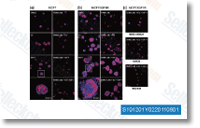fastidiosa, suggesting that auxin signal ing associated genes uncovered in this function aren’t generally pro moting cell growth. About the other hand, auxin synergistically with jasmonic acid/ethylene signaling is required for necrotrophic resistance. Additionally some members of ARF positively regulate camalexin biosyn thesis leading to resistance to necrotrophic pathogens. This defense system, involving the interaction be tween auxin and JA signaling pathways, which almost certainly occurs in Ponkan mandarin, offered the sizeable induc tion of genes related with the two signaling pathways. Camalexin is produced as a result of the tryptophan pathway and in our evaluation two genes involved inside the biosynthesis of tryptophan, dehydroquinate shikimate dehydrogenase and MAPK 9, were induced in Ponkan mandarin, suggesting that ca malexin biosynthesis could be induced in response to X.
fastidiosa infection. Taken with each other each one of these evidences recommend us the resistant Ponkan mandarin recognizes X. fastidiosa in early stage of infection as a necrotrophic pathogen. To confirm that auxin signaling associated genes are in deed upregulated only selelck kinase inhibitor in Ponkan mandarin in response to X. fastidiosa infection we also evaluated the expres sion of auxin marker genes by RT qPCR in Pera sweet orange vulnerable variety and in Ponkan mandarin at one particular day soon after X. fastidiosa infection. As proven in Figure 5, all auxin associated genes had been appreciably induced only in Ponkan mandarin. In Pera sweet orange, the genes had been considerably repressed or showed no sig nificant change. This result evi dences that auxin is induced as a resistance response against X.
fastidiosa GDC0879 through the early stage of infection.Recognition of PAMPs or DAMPs that somehow resem ble necrotrophic pathogens might mediate this response. Nonetheless, this recognition occurs largely during the early stage of infection since we observed a gradual decrease in expression of auxin related genes along the time course of infection. After 21 days, no auxin relevant gene was expressed, whereas expression of salicylic acid marker gene improved. This result agrees with De Souza et al. where an upregulation of SA connected genes was observed in Ponkan mandarin at 30 days after X. fastidiosa inoculation. Following this time stage, the bacter ial population decreases to a point where it couldn’t be isolated. These success recommend the resistant plant improvements its mechanism of defense in the course of X.
fastidiosa in fection, the original response requires the participation of auxin though later on SA gets to be essential. It is to note that the alter occurs about in the time when X. fastidiosa kinds a structured biofilm. On this development con dition this bacterium expresses unique genes and proteins essential for its adaptation  and pathogenicity within the host.
and pathogenicity within the host.
AMPK Signal
AMPK is formed by α, β, and γ subunits
